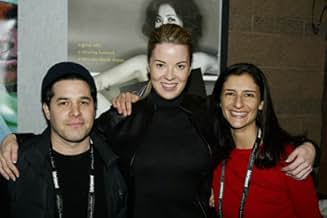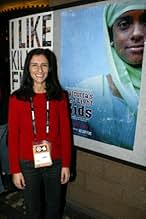CALIFICACIÓN DE IMDb
7.2/10
18 k
TU CALIFICACIÓN
Mientras documenta las experiencias de las prostitutas de Calcuta, la periodista Zana Briski anima a los niños a grabar sus vidas con cámaras.Mientras documenta las experiencias de las prostitutas de Calcuta, la periodista Zana Briski anima a los niños a grabar sus vidas con cámaras.Mientras documenta las experiencias de las prostitutas de Calcuta, la periodista Zana Briski anima a los niños a grabar sus vidas con cámaras.
- Dirección
- Guionistas
- Elenco
- Ganó 1 premio Óscar
- 21 premios ganados y 5 nominaciones en total
Zana Briski
- Self "Zana Auntie"
- (sin créditos)
Sunil Halder
- Self
- (sin créditos)
- …
- Dirección
- Guionistas
- Todo el elenco y el equipo
- Producción, taquilla y más en IMDbPro
Opiniones destacadas
A great documentary, which reveals a sad Indian reality, it makes us think about human rights, especially children. The documentary carries shocking phrases especially because they are spoken by children. At last a great movie even being a sad story.
I saw BIB last night. I expected to love it, since it had won the Oscar and I am a documentary filmmaker. I thought it was a well-crafted documentary, but there was a surprising "ick" factor to the film for me. First, I was turned off by Zana Briski's personality...the way she was talking to the school officials. She seemed self-conscious in her role as the kids' advocate...she sounded stilted, preachy and thus, ineffective. I also didn't like the way she imposed a solution on the kids, a solution that worked for her but not for them. The photography class sounded like a "cool" thing that she could tell her liberal artsy friends about back in England, but was probably less helpful to the kids than social work, a free lunch program or academic tutoring. Also her solution was for the girls to go to a boarding school "to get them away from all this." I thought that showed a lack of understanding about the situation the girls were in. How could they succeed in a boarding school when they probably weren't academically ready? How could they succeed without emotional support, separated from their families? How could their mothers be expected to accept being separated from their daughters? It bothered me the way that the school officials kept telling Avyjit, the brightest and most talented boy, that he would have to work hard and improve his grades. No wonder Avyjit was turned off. How is he supposed to improve his grades when he hasn't had enough structure in his life to develop good study habits? The whole photography project smacked of some well-intended idea by some liberals who thought, "wouldn't it be cool if we gave cameras to a bunch of street urchins and they came up with cool photos? We could do an art show and other do-gooders would think we were cool!" I'm sure Zana Briski intended to help the children and she did help a few, but why did she set out to help so few to begin with? I keep trying to say nice things about the film and end up criticizing it again. It seemed almost like a reality show...pick seven street urchins and shower them with amazing opportunities. Pour tons and tons of resources into a few kids, then make a film about it. Despite dangling the opportunities in the kids faces, more than half of them did not see their lives improve. It was a well-crafted film which educated many people about the plight of these children. I just hope that other people who know more about social work than these filmmakers do, will be able to really help these children. Maybe I will since I have seen this movie.
It would certainly take a filmmaker of much self-consciousness, something which Zana Briski certainly possesses, to make this film the way she has. Having met with uncooperative roadblocks to shooting a documentary about sex-workers and their families within the squalid confines of Calcutta's red-light district, Briski states early on that she decides to have the children themselves tell their story by supplying them with automatic cameras to use in their own personal ways. The film, however, ultimately becomes an account of one outsider's attempt to save these children from their miserable fates - poverty and sexual abuse. With the children's sex-worker mothers and families, many of whom have apparently spent generations in the district with no escape in sight, used as background elements, Briski focuses solely on the children, entering them into an informal photography seminar where they gather to share contact sheets of their pictures and discuss the problems of shooting amidst uncooperative and hostile subjects and why certain pictures work and why some don't. Thankfully, Briski also interviews the children, and while it's not clear they understand her theories on picture composition, they are, despite being denied education and living amidst fairly brutal conditions of abuse, poverty and indentured servitude, very perceptive and wise to the unfortunate conditions in which they live, their prospects and possess an awareness of the possibilities of life outside of the district. Briski becomes further involved with the children by trying to enter them into school, though most will not accept them because they are the children of sex workers. Indeed, it is the indifference of Indian authorities to the children's plight as much as the abuse they receive from their depraved parents that shocks the viewer. Briski, with some help from some photographic arts people in the United States and Amnesty International, is able to use the children's pictures as a commercial vehicle to raise money to enable them to enroll in a private boarding school (the kids are well aware that education is their only way out of the brothels). Here, Briski's movement somewhat takes over the movie from her subjects, proving how futile western notions of compassionate aid often are to endemic and grave third-world situations like we witness here. This is driven home when of the kids accepted into the boarding school, only one eventually remains because of the economic pressures put upon their families in which the children essentially act as indentured servants, performing household tasks day and night and odd jobs for additional income. So, while the film becomes a parade for Briski's noble cause, I would have liked to have seen more background and interaction between the children and their surroundings, other than simply as child photographers who have been given a brief and, for most of them, fleeting reprieve from their depraved surroundings.
Greetings again from the darkness. Rarely does a documentary attract much of an audience ... that is unless it is one of the slanted visions of Michael Moore. Realizing not many will see "Brothels" leaves me feeling both saddened and anxious. What a remarkable story that Zana Briski and Ross Kauffman have brought to our world. The kids will capture your heart within the first few moments of the film. Although the story is definitely the kids, the hero is Ms. Briski. Her tireless efforts to give them hope and a way out should be enough motivation for each of us to realize we can make a difference in the world. This film pulls no punches in showing us the underbelly of one of Calcutta's red light districts and how it so impacts these families. The girls are resigned to the fact that it is their future. The boys are helpless to save their friends. Enter Ms. Briski with cameras in tow. You will feel so energized watching the children explore and capture their world through a lens. The photos are nothing short of stunning and were a hit at the World Festival a couple of years ago. Although not successful in saving them all, Ms. Briski did make a difference and provides a guiding light to us all.
I often disagree with the academy award nominations. It's usually too political to nominate the best movies and performances of the year. Born Into Brothels is an exception, it was nominated and won! The only mistake was not nominating it for best picture.
Brothels is the story of a woman, Zana Briski, who traveled to Calcutta to photograph the brothels. She fell in love with the children and began teaching them photography. The movie is seen through their eyes.
The result is extraordinary in so many ways. Calcutta's red light district is interesting in and of itself. The setting is the first extraordinary feature. The filming makes you feel like you are there. Director Ross Kauffman captures the feeling of being trapped in dark allies with a dark future. Without a director commentary running though the film, you're able to see it all by the way it's been directed. The dark past and future of these families is presented in a beautiful and horrific way.
Secondly, the children are lovable. The story focuses on 8 or 9 children of prostitutes. Each one is unique. Some are incredibly funny, others serious, some are troubled, and at least one has an undeniable talent for photography. You'll leave the theater feeling like you know them.
This is documentary film at its best. It transports us to another country and makes us love the troubled children. What was troubling to me was having to leave the theater never to see these troubled children again. Putting aside the incredible movie-making abilities of these creators, Zana Briski is a true hero.
Brothels is the story of a woman, Zana Briski, who traveled to Calcutta to photograph the brothels. She fell in love with the children and began teaching them photography. The movie is seen through their eyes.
The result is extraordinary in so many ways. Calcutta's red light district is interesting in and of itself. The setting is the first extraordinary feature. The filming makes you feel like you are there. Director Ross Kauffman captures the feeling of being trapped in dark allies with a dark future. Without a director commentary running though the film, you're able to see it all by the way it's been directed. The dark past and future of these families is presented in a beautiful and horrific way.
Secondly, the children are lovable. The story focuses on 8 or 9 children of prostitutes. Each one is unique. Some are incredibly funny, others serious, some are troubled, and at least one has an undeniable talent for photography. You'll leave the theater feeling like you know them.
This is documentary film at its best. It transports us to another country and makes us love the troubled children. What was troubling to me was having to leave the theater never to see these troubled children again. Putting aside the incredible movie-making abilities of these creators, Zana Briski is a true hero.
¿Sabías que…?
- Bandas sonorasSankarabaranam pancha nadai pallavi
Performed by Shenkar and The Epidemics
Selecciones populares
Inicia sesión para calificar y agrega a la lista de videos para obtener recomendaciones personalizadas
Detalles
- Fecha de lanzamiento
- País de origen
- Sitio oficial
- Idiomas
- También se conoce como
- Born Into Brothels: Calcutta's Red Light Kids
- Locaciones de filmación
- Productoras
- Ver más créditos de la compañía en IMDbPro
Taquilla
- Total en EE. UU. y Canadá
- USD 3,515,061
- Fin de semana de estreno en EE. UU. y Canadá
- USD 14,605
- 12 dic 2004
- Total a nivel mundial
- USD 3,529,201
- Tiempo de ejecución
- 1h 25min(85 min)
- Color
- Mezcla de sonido
- Relación de aspecto
- 1.37 : 1(original negative)
- 1.85 : 1
Contribuir a esta página
Sugiere una edición o agrega el contenido que falta









